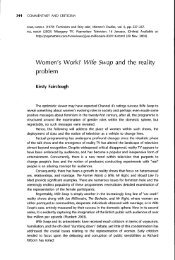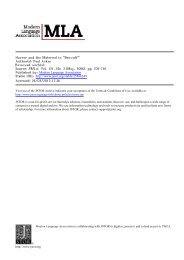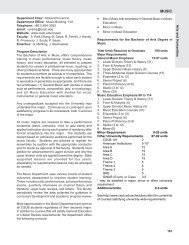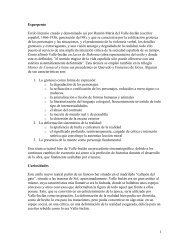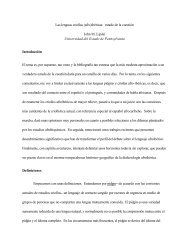English 418 Second Language Acquisition Session Twenty Nine ...
English 418 Second Language Acquisition Session Twenty Nine ...
English 418 Second Language Acquisition Session Twenty Nine ...
You also want an ePaper? Increase the reach of your titles
YUMPU automatically turns print PDFs into web optimized ePapers that Google loves.
<strong>English</strong> <strong>418</strong><br />
<strong>Second</strong> <strong>Language</strong> <strong>Acquisition</strong><br />
<strong>Session</strong> <strong>Twenty</strong> <strong>Nine</strong> Notes<br />
Goals/Objectives:<br />
1) To examine the notion of Simplification and to use evidence from the research to determine when and how to provide it<br />
2) To gain an understanding of an Integrated View of <strong>Language</strong> Learning<br />
3) To understand the Stages that learners go through to integrate second language input<br />
Questions/Main Ideas (Please<br />
write these down as you think<br />
of them)<br />
Notes:<br />
• <strong>Second</strong> <strong>Language</strong> Instruction<br />
• To simplify or not to simplify?<br />
• We have discussed the distinction between input and intake<br />
• (McLaughlin): Adult second language learners are limited capacity processors of<br />
information<br />
• Limited in what they can attend to at a given point in time<br />
• <strong>Second</strong> <strong>Language</strong> Instruction<br />
• If the task is too difficult, a large amount of cognitive effort is needed and attention may be<br />
focused only on selected items in the input<br />
• On the other hand, if the task is simplified, then less cognitive effort is required and some<br />
attention may then be allocated to attend to other items in the input<br />
• <strong>Second</strong> <strong>Language</strong> Instruction<br />
• Because human beings have limited cognitive capacity, it follows that maximum use of<br />
various information-handling techniques could be used to overcome some of these<br />
limitations in SLA<br />
• One technique for avoiding cognitive overload is simplification<br />
• <strong>Second</strong> <strong>Language</strong> Instruction<br />
• Simplified input constitutes second language input that has been modified by a speaker to<br />
facilitate second language learners’ comprehension<br />
• The comprehensibility of the input, it is argued, indirectly affects language acquisition by<br />
providing (ironically) more linguistic information to the learners’ developing linguistic<br />
systems than if a more complex form was used<br />
• <strong>Second</strong> <strong>Language</strong> Instruction
• Learners are able to attend to forms and structures that may not yet be a part of their<br />
developing grammars because they are not overloaded with complicated input<br />
• This simplification process does not work they way that most people think, however<br />
• Simplification was originally known as foreigner talk or pidgin <strong>English</strong><br />
• <strong>Second</strong> <strong>Language</strong> Instruction<br />
• Based on something called motherese¸ the idea that mothers (and fathers) adjust their<br />
speech when addressing child learners<br />
• The argument is that for the beginning learner, it makes communication possible<br />
• When they realize that communication is possible, they realize that they can succeed (that<br />
is, they can communicate) and this in turn increases motivation<br />
• <strong>Second</strong> <strong>Language</strong> Instruction<br />
• Critiques:<br />
• Caregiver language is not necessarily more simple<br />
• Rather, it is focused on ideas and meaning, not form<br />
• They simplify the chunks of meaning, not the language forms<br />
• <strong>Second</strong> <strong>Language</strong> Instruction<br />
• Tarone – the concept of foreigner talk is a modification of the speech of one of the<br />
interlocutors, the native speaker<br />
• Whereas communication strategies are a joint attempt by both interlocutors to agree on a<br />
meaning<br />
• <strong>Second</strong> <strong>Language</strong> Instruction<br />
• Like error correction, simplification seems to work when it is part of the ongoing effort to<br />
communicate<br />
• Therefore, simplification must also be used judiciously<br />
• Building a Personal Theory of SLA<br />
• An Integrated View of <strong>Second</strong> <strong>Language</strong> <strong>Acquisition</strong><br />
• The learning of a second language is a multi-faceted endeavor<br />
• In order to fully understand this phenomenon, one must consider what is learned and what<br />
is not learned<br />
• As well as the contexts in which learning and non-learning take place<br />
• Building a Personal Theory of SLA<br />
• All of the things that we have been discussing are crucial in dealing with a part of what<br />
happens in learning a second language
• None, however, is able to account for the total picture<br />
• A personal SLA theory must explain how the various pieces fit together and explain how<br />
each relates to a larger picture of acquisition<br />
• Building a Personal Theory of SLA<br />
• You must consider what a learner must do to convert input to output<br />
• There are five stages to this process:<br />
• (a) apperceived input<br />
• (b) comprehended input<br />
• (c) intake<br />
• (d) integration<br />
• (e) output<br />
• Building a Personal Theory of SLA<br />
• Constructing a Personal Theory<br />
• First: you must decide whether or not acquisition can best be characterized by means of<br />
innateness<br />
• Is it nature or nurture<br />
• Does the learner come to the learning task with an underlying grammar? (Innatism)<br />
• Or does language learning result from social interaction? (Behaviorism)<br />
• Building a Personal Theory of SLA<br />
• Those working within the first paradigm take as the scope of investigation linguistic<br />
descriptions of grammars<br />
• In so doing, an idealized speaker-hearer is assumed, with the claim being made that in order<br />
to fully understand formal constraints on language, one needs to isolate that linguistic<br />
system and investigate it in and of itself without external influences<br />
• Building a Personal Theory of SLA<br />
• In the social interactionist view, language and social interaction cannot be separated without<br />
resulting in a distorted picture of the development of linguistic and interactive skills<br />
• <strong>Language</strong> and cognitive development are deeply embedded in the context<br />
• Thus, understanding the development of syntax, for example, can only come about as one<br />
investigates how syntax interacts with other relevant aspects of language<br />
• Building a Personal Theory of SLA<br />
• These conflicting positions have resulted in the development of different research traditions<br />
as a result of the different questions being asked
• This, in turn, has resulted in conflicting views about the best way to gather data and the<br />
correct questions to be asked<br />
• Building a Personal Theory of SLA<br />
• Next, what is the role of input?<br />
• (Regardless of which perspective above you choose, it is clear that input of some sort is<br />
necessary in order for acquisition to take place)<br />
• We should first note that learners are exposed to a large body of second language data<br />
• Building a Personal Theory of SLA<br />
• A well-established fact about second language acquisition is that not everything that<br />
learners hear/read is used to form internal grammars<br />
• Some data filters through, some does not<br />
• In other words, some data is apperceived, some is not<br />
• The first stage of input utilization is called apperceived input<br />
• Building a Personal Theory of SLA<br />
• Apperception is the process of understanding by which newly observed qualities of an<br />
object are related to past experiences<br />
• In other words, past experiences relate to the selection of what might be called noticed<br />
material<br />
• Apperception is an internal cognitive act, identifying a linguistic form as being related to<br />
some prior knowledge<br />
• Building a Personal Theory of SLA<br />
• You can think of apperception as a priming device that tells us which parameters to attend<br />
to in analyzing second language data<br />
• That is, it is a priming device that prepares the input for further analysis<br />
• What is noticed, then, interacts with a parsing mechanism that attempts to segment the<br />
stream of speech into meaningful units for the learner<br />
• Building a Personal Theory of SLA<br />
• Thus, apperceived input is that bit of language that is noticed in some way by the learner<br />
because of some particular features<br />
• Why are some aspects of language noticed by the learner, whereas others are not?<br />
• What are the mediating factors at this initial stage?<br />
• What factors serve as input filters?<br />
• Building a Personal Theory of SLA
• One obvious factor is frequency<br />
• Something that is very frequent in the input is likely to be noticed<br />
• On the other hand, something that is unusual because of its infrequency may stand out for a<br />
learner<br />
• Building a Personal Theory of SLA<br />
• A second factor that influences apperception is affect<br />
• This category can include such factors as:<br />
• Social distance<br />
• Status<br />
• Motivation<br />
• Attitude<br />
• Building a Personal Theory of SLA<br />
• A third factor that may determine whether language data are apperceived is prior<br />
knowledge<br />
• Learning involves integration of new knowledge with prior knowledge<br />
• One needs some sort of anchor on which to ground new knowledge<br />
• Building a Personal Theory of SLA<br />
• Prior knowledge factors can include:<br />
• Knowledge of the native language<br />
• Existing knowledge of the second language<br />
• Knowledge of other languages<br />
• World knowledge<br />
• <strong>Language</strong> universals<br />
• Building a Personal Theory of SLA<br />
• A final factor is that of attention<br />
• At a given point in time, does a learner attend to the input?<br />
• Attention is important because it allows a learner to notice a mismatch between what he or<br />
she knows about the second language and what is produced by speakers of the second<br />
language<br />
• Building a Personal Theory of SLA<br />
• Input can be apperceived (and is hence comprehensible), but may not be comprehended<br />
• Comprehensible input is controlled by the person providing the input, generally a native<br />
speaker of the language
• Comprehended input is controlled by the learner<br />
• Building a Personal Theory of SLA<br />
• That is, it is the learner who is or who is not doing the “work” to understand<br />
• This distinction is crucial in the eventual relationship to intake, because it is the learner who<br />
ultimately controls that intake<br />
• Building a Personal Theory of SLA<br />
• Apperception can be conceptualized as a priming device<br />
• It prepares the learner for the possibility of subsequent analysis<br />
• In comprehending, however, the task facing the learner is to analyze the input in order to<br />
determine how to incorporate it into their grammars (interlanguage)<br />
• Building a Personal Theory of SLA<br />
• Therefore, there is another separation of components – that of comprehended input and<br />
intake<br />
• This separation is important because not all input that is comprehended becomes intake<br />
• Building a Personal Theory of SLA<br />
• For example, input may be comprehended only for the immediate purpose of a<br />
conversational interaction<br />
• Or it may be used for purposes of learning – where the intake is incorporated into the<br />
learner’s grammar<br />
• Building a Personal Theory of SLA<br />
• In SLA theory, intake refers to the process of attempted integration of linguistic<br />
information<br />
• Thus, input that is only used in a conversation and for the sake of that conversation is not<br />
regarded as intake<br />
• Building a Personal Theory of SLA<br />
• Intake is the process of assimilating linguistic material<br />
• It refers to the mental activity that mediates between input and grammars and is different<br />
from apperception or comprehension as the latter two do not necessarily lead to grammar<br />
formation<br />
• Building a Personal Theory of SLA<br />
• Thus, input and intake refer to two fundamentally different phenomena<br />
• Intake is that component where psycholinguistic processing takes place<br />
• It is where incoming information is matched against prior knowledge
• Building a Personal Theory of SLA<br />
• And where, in general, processing takes place against the backdrop of existing internalized<br />
grammatical rules<br />
• This is the place where generalizations and over-generalizations are likely to occur<br />
• It is where fossilization stems from<br />
• Building a Personal Theory of SLA<br />
• This is the component where several major processes occur, including:<br />
• Hypothesis formation<br />
• Hypothesis testing<br />
• Hypothesis rejection<br />
• Hypothesis modification<br />
• Hypothesis confirmation<br />
• Building a Personal Theory of SLA<br />
• After there is language intake, there are several possible outcomes:<br />
• 1) Hypothesis confirmation/rejection (intake)<br />
• This results in intake<br />
• Building a Personal Theory of SLA<br />
• 2) Apparent non-use<br />
• This stems from the fact that the information contained in the input is already incorporated<br />
into a leaner’s grammar<br />
• This does not preclude it from being used, however<br />
• Building a Personal Theory of SLA<br />
• The additional information may be used for rule strengthening or hypothesis<br />
reconfirmation<br />
• Part of becoming a fluent speaker of a second language involves the automatic retrieval of<br />
information from one’s knowledge base<br />
• Building a Personal Theory of SLA<br />
• Information that may appear to be redundant may in fact be serving an important purpose in<br />
terms of the access a learner has to that information<br />
• 3) Storage – perhaps some level of understanding has taken place, yet it is not clear how to<br />
integration can or should take place<br />
• Building a Personal Theory of SLA<br />
• 4) Non-use
Summary/Minute Paper:<br />
• In this final possibility, learners make no use of the input at all<br />
• This may be because they have not succeeded in comprehending it at a useful level<br />
• Building a Personal Theory of SLA<br />
• Finally, what is the role of output?<br />
• There are two points to emphasize:<br />
• First, there is the role of comprehensible output in the testing out of hypotheses<br />
• This provides a feedback loop back into the intake component<br />
• Building a Personal Theory of SLA<br />
• <strong>Second</strong>, there is the role output plays in forcing a syntactic rather than solely semantic<br />
analysis of language<br />
• This provides a feedback loop to comprehended input<br />
• Thus, output is an active part of the entire learning process<br />
•





